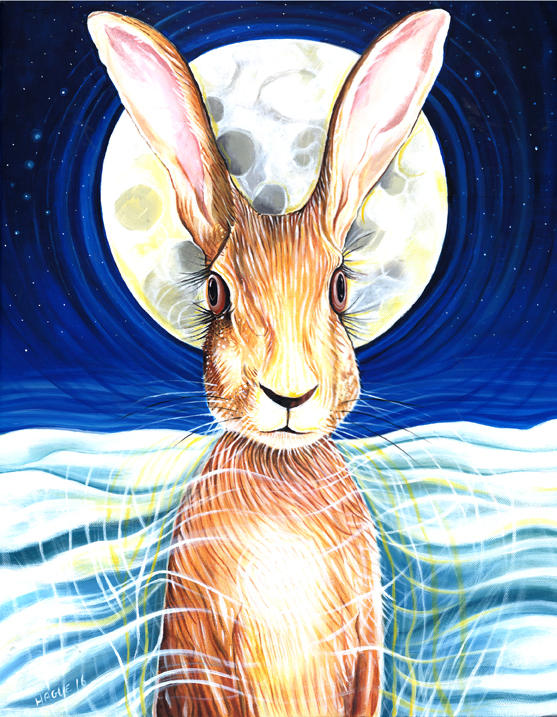The Hare, Moon Egg & the Goddess called Easter
Holy Week is upon us across much of the Western Hemisphere. A time when children are often taught to connect Easter’s Pagan origins with the Judeo-Christian belief in a savior god. A connection that uncomfortably tries to equate ‘a giant rabbit or ‘hare’ with a crucified Sun God. It’s a mad, ‘mad world’, especially when ‘State and religion’ would have children focusing on the ‘ritual killing’ of Jesus (the crucifixion), in one hand, and celebrating the return of a ‘giant bunny’ delivering chocolate eggs with the other. Giant bunnies, chocolate eggs, alongside the crucifixion story of course, is not found in the ‘holy book’ but nonetheless the modern world celebrates ‘Easter time’ with the same vigor as it does every other festival on the calendar. No wonder the ‘official stories and their associated festivals such as Easter, don’t make much sense when you combine narratives and take stories ‘literally’. None of it makes sense unless we venture deeper into Pagan symbolism ‘connecting’ the cycles of the Sun and the Moon’ from our ‘earthly perspective’. In this fairly long blog I am going to weave together the main themes associated with Easter and as usual delve a little deeper into the symbolism. For more indepth esoteric knowlegde see my book, Orion’s Door. For those that haven’t got time to read the whole blog, the video below gives much insight into Easter, the Hare and the ‘light within’.
The Sun Cross
Christians refer to the week before Easter as ‘Holy Week’ as it contains the days of the Easter ‘Triduum’, including ‘Maundy Thursday’ and ‘Last Supper’, as well as ‘Good Friday’ (not so good for some). Without going into great detail regarding ‘sun gods’, (as I want to focus on the ‘moon, hare and egg symbolism’), Jesus comes from a ‘long line’ of pre-Christian ‘Sun gods’ that were killed and rose again to redeem the sins of the world; See ancient Babylon, Tammuz, Bal and the Norse god Balder to name but a few. If one does the research, there is well over a dozen versions of the ‘Sun of god’ found all over the ancient world pre dating Christ. The sun-cross circle below is what connects the Sun and Moon to the main festivals marked by the Equinoxes and Solstices on what was and still is the Pagan calendar.
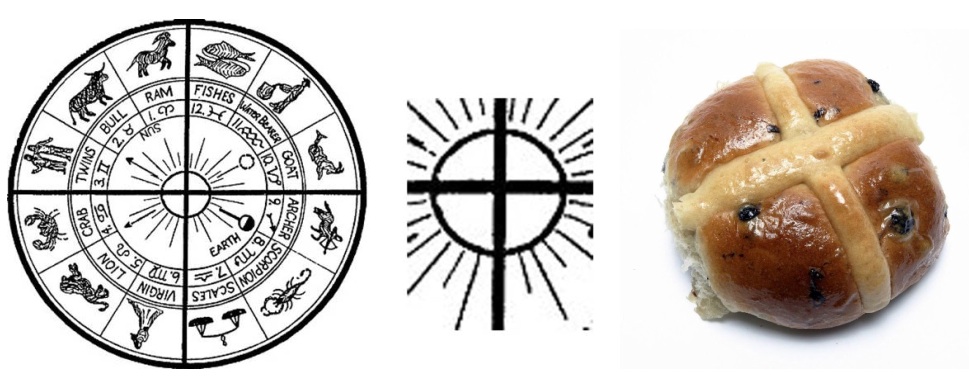
When one looks more closely at the religious symbolism associated with celebrations and festival such as Easter it becomes obvious to see the correlations of time being ‘marked’ through the various ‘stages’ of the Sun and the Moon in relation to how we ‘see’ life and our ‘time’ here on Earth. The three main symbols for the Sun, Moon and Earth (sometimes Venus) have all been worshipped for thousands of years at points on the calendar (see below). The eight pointed star of Ishtar is often found alongside the crescent (Sin) and the rayed solar disk (Shamash) in Babylonian iconography on boundary stones, cylinder seals. In the Christian version of Easter some ‘Boundary stones’ are still ‘marked’ or ‘hit’ with a broom or stick to this day in some English churches. It all makes sense when we ‘see’ that Easter came out of the pre-Christian world.

Lunar-‘tick-tock’ Calendars (Moon & ‘Sun-Saturn’ Symbolism)
Easter and the holidays that are related to the Moon calendar are called ‘moveable feasts’ which do not fall on a ‘fixed’ date in the Roman Catholic inspired Gregorian or Julian calendars. These calendars instead follow the cycle of the sun with ‘irregular’ Moon days. Easter ‘time’ is determined through what is called a ‘lunisolar calendar’, which is similar to the Hebrew calendar. In 325 AD it was the Council of Nicaea that decided Easter would fall on the first Sunday after the ecclesiastical full moon or soonest after the Spring Equinox on the 21st March. Those ‘Pagan founding fathers’ of the Christian church knew how to ‘use the Moon’. Saturn (the ‘Dark Sun’) underpins the vibrational (invisible) structure given to us by the Moon and therefore the calenders are no more than a ‘Saturn-Sun & Moon vibrational illusion’. Or as authors like David Icke call the Saturn-Moon Matrix.
The Moon is the ‘marker of time’ (Saturn’s creation) and therefore gives us the illusion of time. The ‘white rabbit’ and his ‘pocket watch’ in Alice in Wonderland, for example, are all ‘symbols’ for the Moon, Saturn and the Goddess (Alice) in ‘wonderland’ – the illusion. Alice (the Goddess archetype) is ‘trapped’ by time in the Saturn-Moon matrix. In ancient Chinese and the Japanese calendars the hours were counted through animal names, and for these cultures the ‘artificial day’ began at six o’clock in the morning when the ‘Sun rises’ in the middle of what they called the ‘hour of the Hare’. It was the hour of the crossing between night and day. More on the hare and Rabbit soon.
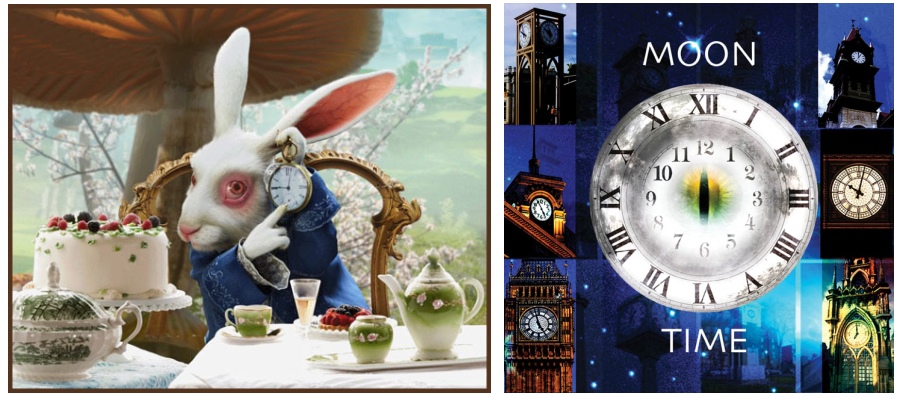
Easter is also linked to the Jewish Passover (Pesah or Pesakh in Assyrian) through much of its symbolism, as well as by its position in the lunisolar calendar. Jewish people celebrate Passover as a commemoration of their liberation by God from slavery in Egypt thanks to Moses (Exodus). The Nehustan (the brazen serpent on the cross attributed to Moses) gives us more insight into the ‘Passover-Easter’ (Saturn-Sun) connection. The serpent symbolism refers to ‘chaos calmed’ and given a ‘new order’. Out of chaos comes Order and a New Age, a liberation by the said Moses or Jesus saviour figure. The ‘light of the world’ is renewed at Easter (spring time) and the saviour gods found in much ancient myth are symbols for this renewal on one level. The Passover is also one of the ‘three pilgrimage’ festivals during which the population of the kingdom of Judah would have made a pilgrimage to the Temple in Jerusalem. Today Samaritans still make this pilgrimage to Mount Gerizim, and along with Moriah and Zion they give us the ‘three’ scared mountains in Jerusalem. The number three will become relevant shortly.
The Goddess Ostara (Easter)
In ancient Indo-European myths ‘Ostre’ or ‘Ostara’ was associated with the ‘light of spring’ and the Goddess who brings the ‘new light’. She made the clocks go ‘forward’ so to speak. The Goddess Ostara is also linked to the festival of Easter, hares and ‘sacred eggs’. She is another version of ‘mother nature’ and the ‘awakening of the feminine’ principle behind the Sun’s light. In other forms she is known as Ishtar (star), Freyja and Anunitu, who on the Spring Equinox, was said to mate with the ‘solar god’ (the Sun) and conceive a child that would be born nine months (moons) later on the Winter Solstice. We all know who the child is supposed to be? The same poor child of the ‘Sun and the Moon’ gets nailed to Moses’s ‘Saturn cross’ every Easter.
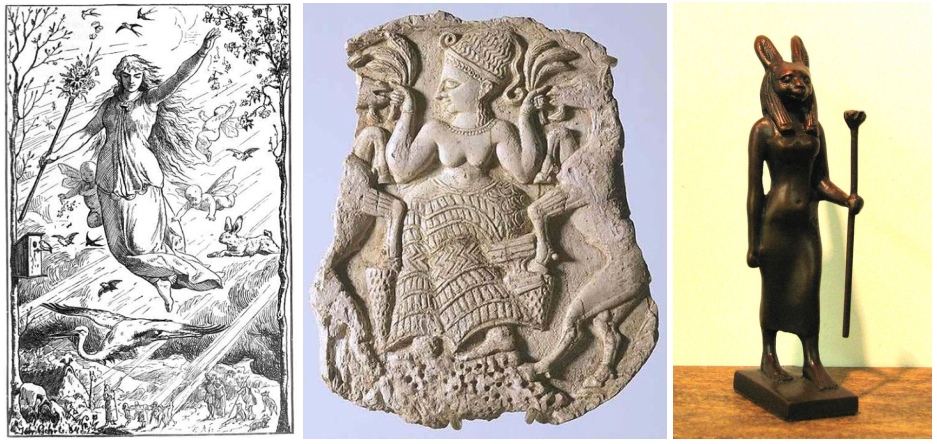
The Mesopotamian (Akkadian, Assyrian and Babylonian) goddess Ishtar was another version of the ‘goddess of light’, among other things. She was also the ‘goddess of fertility’, love, war, sex and power. Ishtar, like Ostara, was said to have ‘two sides’, or ‘two natures’, both ‘creative and destructive’. Ishtar is also Aja (the eastern mountain dawn goddess) and Anatu (possibly Ishtar’s mother). She is also Anunitu (the Akkadian goddess of light), Agasayam (war goddess), Irnini (goddess of cedar forests in the Lebanese mountains), Kilili (symbol of the desirable woman), Sahirtu (messenger of lovers), Kir-gu-lu (bringer of rain) and Sarbanda (power of sovereignty). Both Ostara and Ishtar (same deity) are the goddess that ushers in the ‘time’ we call Easter. Astarte (English) Ashtaroth (Hebrew) are also the name for the Canaanite fertility goddess associated with the ‘beginning of spring’ and Easter. Astarte was also considered the goddess of the ‘underworld’ (Saturn’s domain) and her other name was El, the Queen of the underworld (see IS-RA-EL). Note that ‘ceremonial acts of war’ (terror) and the marriages of prominent blood lines seem to occur at the start of spring (Ostara) through to Walpurgis (Witches night) and Beltane (May the 1st). The pagan calendar of course is also ‘used’ by those follow Satanism, hence the endless acts of destruction we witness in the world conjured up by those in the shadows.
The Ancient Hare and Rabbit Goddesses
Another animal symbol for pagan lunar magic, nature and witchcraft is the hare. Many of the Goddesses mentioned above were either said to have a hare as a companion or could take the form of a hare. In ancient Egypt Osiris was sacrificed to the Nile each year ‘in the form of a hare’ (below left) to guarantee the annual flooding that Egyptian agriculture (and indeed their entire society) depended upon. A minor Egyptian goddess named Unut or Wenet (above right) also had the head of a hare. The hieroglyph ‘Wn’ (Wen) itself stands for the ‘essence of life’ and often depicts a hare over flowing water. The hare is often depicted ‘greeting the dawn’ (the ‘hour of the hare’) and she sometimes serves as messenger for the god Thoth. Sirius (Thoth), Lepus (Wenet) and Orion (Osiris) are the three main constellations that usher in the turning points of the autumn and spring equinoxes.
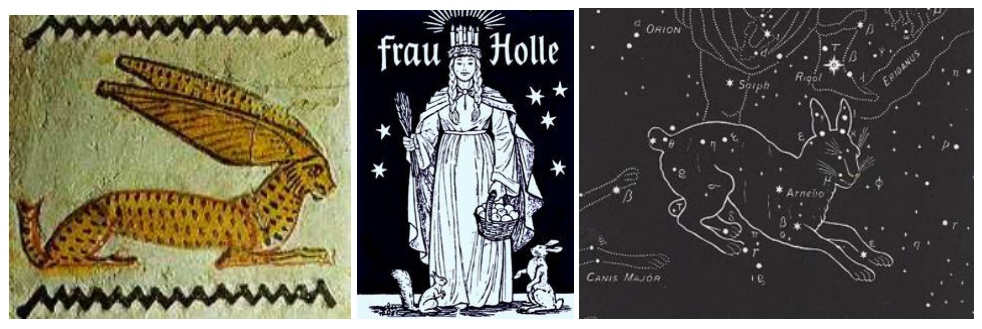
In Norse mythology, there was said to be a goddess before Odin (Saturn worship) replaced the Germanic tribal gods and goddesses. She was called Frau Holle, or Hulda, (above middle). Frau Holle was the goddess of the ‘wild hunt’, much like the goddess Artemis of Greece, and she was often shown with a large group of hares bearing torches ‘illuminating her way’. The hare as a hieroglyph signifies ‘the keeper of the ‘Great Mystery’ and was thought as a symbol of ‘becoming’, or ‘to be’. The hare’s ability to ‘disappear quickly’ was seen as a symbol for ‘states of awareness’ and transfiguration.
In some Native American myths, the hero Michabo or Great Manitou, was said to be the ‘great hare’ that brought knowledge to some of the American Indian tribes. Many North American tribes spoke of this deity as their common ancestor. Michabo was considered a personification of the Sun’s light, a life giver and his name compounded of ‘michi’ means ‘great’, and ‘wabos’, which means both ‘hare’ and ‘white’. The hare is a mammal that lives in solitude and can navigate the hours of darkness and is said to a have a ‘foot in two worlds’. Michabo of the dawn (or the ‘great white hare’) was considered the guardian of many Native American tribes. He was said to be the founder of their religious rites, the inventor of picture-writing and preserver of Earth and Heaven.
Destroy this Temple’, and I will make it ‘rise again’ in ‘three Hares’
Another version of Ostara (Astarte) is Hecate, the ‘triple headed goddess’ associated with ‘crossroads’, entrance-ways, light, magic, witchcraft, knowledge of herbs (poisonous plants), ghosts, necromancy and sorcery. The number three is a profound symbolic number that is found ‘everywhere’, from the triquetra (below), three primary colours, to the ‘three days’ the egg of the ‘queen bee’ takes to hatch. In numerology three is is considered to be ‘feminine’ and the Tarot card representative of the 3 energetically is The Empress (Hecate).
Three is also the ‘Trinity’ and these are the three aspects of Shin in the Kabbalah whose ‘three wicks’ are a symbol of the ‘holy trinity’ through the letter Shin (below right). The god Brahma of Hindu belief also provides symbolism of the Trinity, ‘three heads’ and the egg (Eeaster egg).

n many uses of numerology and ancient belief, three is an important number for ‘creating reality’ and ‘manifestation’. The symbol of the ‘three hares’ (below) found at sacred sites from the Middle and Far East to the churches of Devon are all versions of Hecate’s (Ostara’s) ‘power of manifestation’ and ‘renewal’.
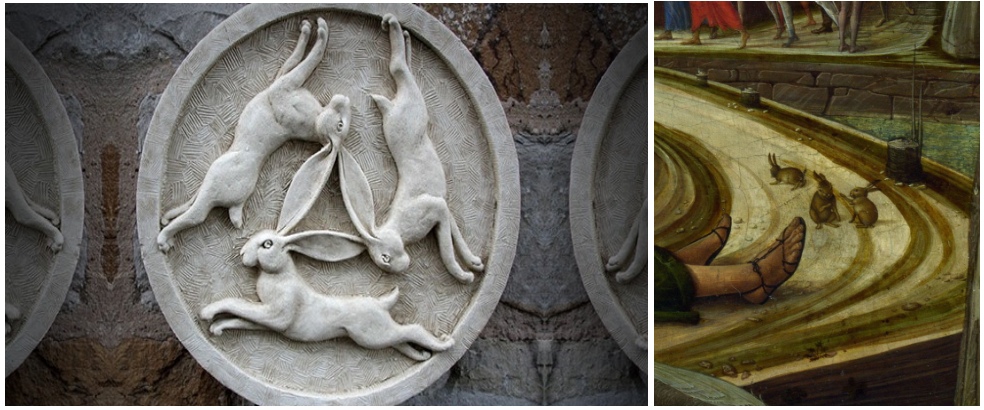
The Italian Renaissance painter Andrea Mantegna, a Knight from a ‘bloodline of painters’, depicts the ‘three hares’ in his masterpiece, The Agony in the Garden(1458-60). The full painting shows angels bearing the Instruments of ‘the Passion’ appearing to Christ in prayer. Three disciples sleep, with ‘three’ hares at their feet and in the background Judas comes with soldiers to arrest Christ. The symbolism, which was obviously known to Mantegna (and the elite) relates to the ‘Trinity of the Church’ that would be born out of the Passion. The painting also relates to fertility, lunar cycles and the ‘goddess of renewal’. The Triskele symbol below carries the same meaning.

The ‘ears of the hares’ form a trivium (or trapezium), which in 3D is a tetrahedron (above right). The tetrahedron (the first of five geometric platonic shapes that are said to construct reality), is a symbol of ‘creation’, ‘fire’ and ‘renewal’. The Vesicae Piscis is also formed by the ‘three ears’ and the same shapes give us the spinning Mer-Ka-Ba (Star tetrahedron) or ‘vehicle of light’ (above right). The symbolism of ‘new life’ and ‘renewal’ entwined in the story of Christ (who was said to baptize with ‘fire’), quite clearly comes from the Pagan understanding of the ‘goddess of light’. The goddess who could see three ways simultaneously and use the ‘light’ to change the illusion. So can we if we tap into this unseen power.
Another version of Ostara also found in Norse Mythology is the goddess Freyja who is associated with love, sex, beauty, fertility, gold, war and death. Freyja is the owner of the ‘necklace Brísingamen’, she rides a chariot pulled by two cats, she keeps the boar Hildisvíni by her side, possesses a cloak of falcon feathers and is accompanied by dwarves. Freyja and her ‘seven dwarfs’ are symbols for the ‘seven days of the week’ which construct the Lunar month (Snow White), seen below in their ‘spring time’ kingdom. Snow White is Freyja and Ostara combined and the symbolism especially through colour relates to the feminine archetype, duality and light of ‘eternal spring’.

The evil queen (the dark archetype) in Snow White, along with the innocent magical goddess that over throws the queen, can also been found in Lewis Carroll’s books Alice in Wonderland and Through the Looking Glass. All are stories that use goddess symbolism associated with ‘moving between’ different realities, just as the Earth’s Equinoxes and Solstices are markers between changing worlds. The Chinese ‘Moon Goddess’ Chang’e comes to mind.
The Easter Moon Rabbit (Hare)
The moon rabbit in folklore was said to be a rabbit that lives on the Moon, some say, based on the pareidolia that identifies the markings of the Moon as a rabbit (see below right).
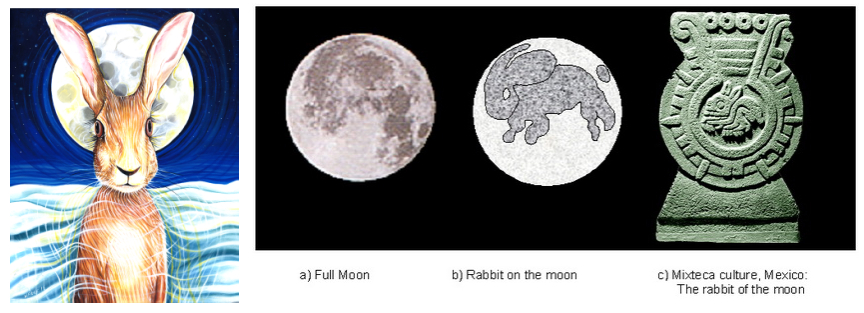
Stories exist in many cultures, prominently in Asian folklore and Aztec mythology of a Moon rabbit. In East Asia, the rabbit is seen pounding in a mortar and pestle (below left), but the contents of the mortar differ among Chinese, Japanese, and Korean folklore. In Chinese folklore, the moon rabbit is often portrayed as a ‘companion’ of the Moon goddess Chang’e, constantly pounding the ‘elixir of life’ for her. The elixir could relate to the ‘egg’ and how life is created through DNA. In Japanese and Korean versions, it is pounding the ingredients for rice cake. Maybe the inspiration for the ‘cake’ Alice eats in Wonderland? More on Alice in a moment.
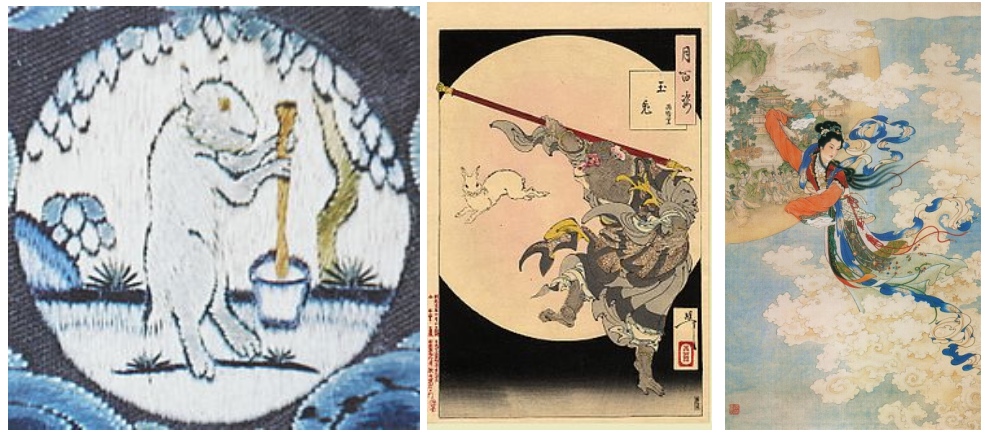
In other Asian myths Sun Wukong fights the ‘Moon Rabbit’ (above middle), a scene in the 16th century Chinese novel Journey to the West, depicted in Yoshitoshi’s One Hundred Aspects of the Moon (1839-1892). In the Buddhist Jataka tales, a monkey, an otter, a jackal, and a rabbit resolved to practice charity on the day of the ‘full moon’ (Uposatha), believing a demonstration of great virtue would earn a great reward. When an old man begged for food, the monkey gathered fruits from the trees and the otter collected fish, while the jackal wrongfully pilfered a lizard and a pot of milk-curd. The rabbit, who knew only how to gather grass, instead offered its own body, throwing itself into a fire the man had built. The rabbit, however, was not burnt. The old man revealed himself to be Akra (Lord of Heaven) and, touched by the rabbit’s virtue, drew the likeness of the rabbit on the Moon for all to see. It is said the lunar image is still draped in the smoke that rose when the rabbit cast itself into the fire. The same story of the Moon god sacrificing itself in the solar fire can be found in Hopi, Mexican and Mayan myths, not least in the stories of Quetzalcoatl. ‘Cotton tail’ in Hopi myth was a god born of the Sun and the Moon after jumping into the solar fire. Many of these stories are symbolic of the upheavals that took place in the heavens.
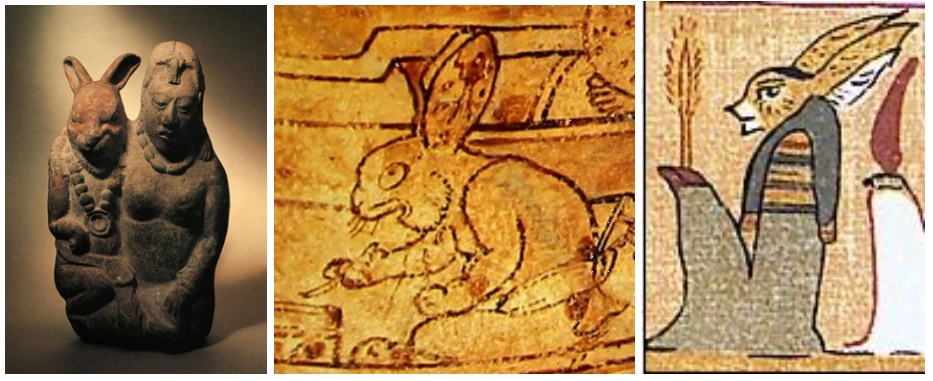
The Goddess & the White Rabbit
Celtic myth talks of the goddess Cerridwen who represented the human cycles of ‘birth’, ‘life’, ‘death and rebirth’. Cerridwen was another Moon Goddess associated with the Hare. In one legend the hunter Ossian was said to have wounded a hare forcing it find sanctuary in a thicket. When Ossian followed it he found a door in the ground that led to vast hallway and in that ‘underground kingdom’ he met a beautiful woman sitting on a throne, bleeding from the leg. Tales like this are plenty in the pre-Christian world and hint at metamorphosis.
Japanese myth also tells of the Hare of Inaba and the goddess Amaterasu and her search for a place for their palace or kingdom. Like the white Rabbit in Alice in Wonderland, Inaba suddenly appears to point the way to Amaterasu (see below). According to the folk tale, the white hare bites Amaterasu’s clothes and takes her to a ‘otherworldly’ location to look for a temporary palace at Nakayama Mountain and Reiseki Mountain. The ‘mountain’, the ‘Goddess’ and the ‘white hare’ are all symbols for the ‘Moon’, ‘time’ and ‘forces that create the collective world reality’.

The white rabbit often appears in 15th Century Renaissance paintings to symbolise the connection between the goddess, the oceans and the Moon. Other meanings relate to venus, love and the ‘duality’ of male and female, as shown in the painting Venus, Mars and Cupid 1490 by Piero di Cosimo (below). It shows cupid lying on Venus next to a white rabbit. The lovers (Venus and Mars) are exhausted by their sexual activity (cupid) and the white rabbit is the symbol for ‘timelessness’ brought on through sexual excess. Moon, Mars and Venus ‘alignments’ have been linked to upheavals on Earth. See the work of Immanuel Velikovsky.
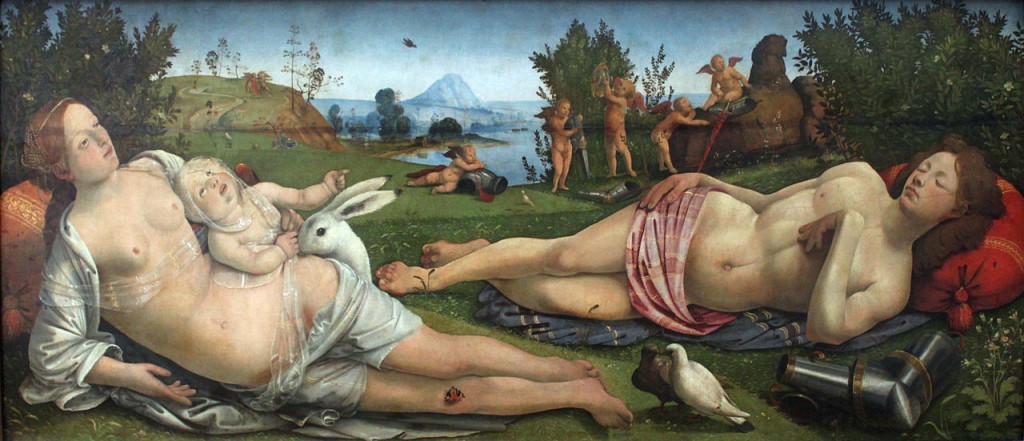
The idea of rabbits as a symbol of ‘vitality’, ‘rebirth’ and ‘resurrection’ clearly comes from the Pagan world and the Italian masters must have known this when they made such ‘Christian works of art’. They were having a laugh! The elite painter Titan in his work, Mary and Infant Jesus with a rabbit (below), is clearly alluding to the Pagan knowledge associated with the goddess and the white rabbit/hare. The painting of St. Jerome reading in the countryside, by Giovanni Bellini (below left) with a white and brown hare/rabbit clearly relates to the power of ‘solitude’ (the hare) and the world that would await the hermit once he leaves the cave to ‘follow the white rabbit’. Jerome was the ‘founding father’ of the Christian Church, (often shown in Saturn red with the lion), instead here he is depicted as the hermit in the wilderness.
The character Neo in the Matrix movie is also shown the ‘white rabbit’ as a way out of his illusionary ‘solitary’ world so he can meet the ‘god of the dreamtime’ – Morpheus.
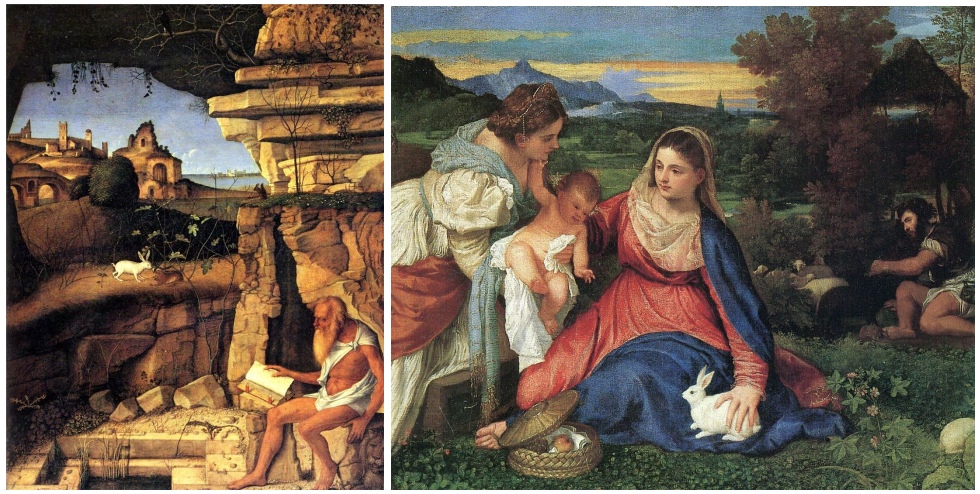
The Trickster Hares
Many native cultures saw the hare as a trickster and shape-shifter. The hare appears in English folklore in the saying “as mad as a March hare” and in the stories of a witch who takes the form of a white hare and goes out looking for prey at night. The Br’er Rabbit stories are loosely related to the trickster element of the rabbit and hare. Cottontail was a symbol for both the ‘hare’ and ‘time’. Interestingly, the hare was said to be a ‘child of Pan’ and in many myths the hare was wrapped in ‘goat’s skin’. Of course the ‘hare’ and the ‘Moon’ are symbolically connected as I’ve shown. The hare also takes on the role of a ‘demiurge’ in some myths and this aspect is connected to the ‘egg’ as we shall see.
African folk tales told by the Namaquas relate the story of phases of the moon with the idea of immortality, alternate disintegration and reintegration, decay and growth repeated perpetually. Even the ‘rising and setting of the moon’ was interpreted by them as its ‘birth and death’. They say that a long time ago the Moon wished to send to mankind a message of immortality, and the hare undertook to act as the messenger. So the Moon charged him to go to humanity and say, “As I die and rise to life again, so shall you die and rise to life again.” It is said that the hare ‘reversed’ (inverted) the message (so life became death) and humanity instead ‘focused on their mortality’.
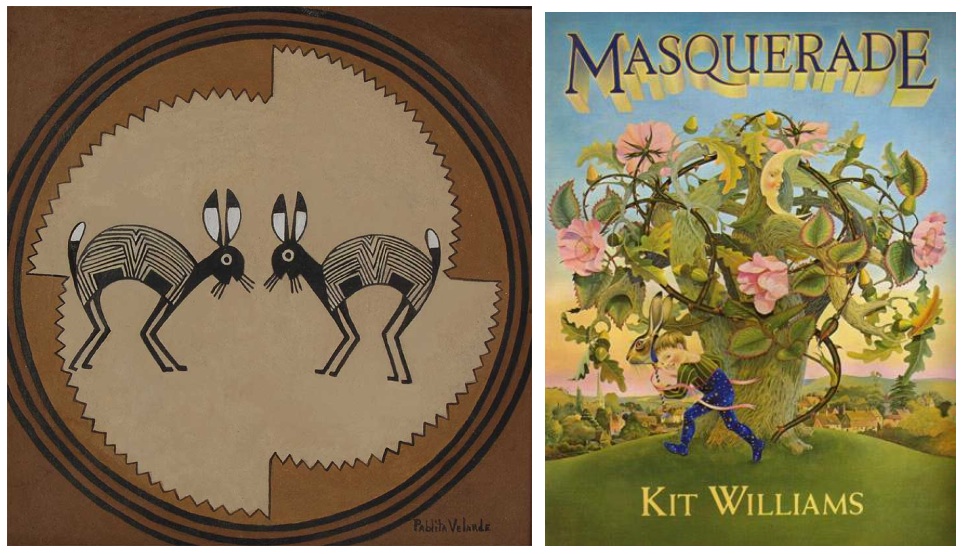
Kit William’s Book Masquerade (1979) relays the ‘trickster element’ of the hare. The book’s objective, the hunt for a valuable treasure, became his means to this end. Masquerade features ‘fifteen’ (Saturn’s number) detailed paintings illustrating the story of a ‘hare’ named Jack. The boy Jack seeks to carry a treasure from the Moon (depicted as a woman) to her love object, the Sun (a man). On reaching the Sun, Jack finds that he has lost the treasure, and the reader is left to discover its location of the ‘golden hare’. The author Kit williams must have been inspired by the pagan myths associated with the Sun, the Moon and the hare?
Scary Hares
The púca (Irish for spirit/ghost), pooka, phooka, or púka is primarily a creature of Celtic folklore. A púca was considered to be a bringer of both good and bad fortune, they could either ‘help or hinder’ communities. These creatures were said to be ‘shape changers’ (shape-shifters) that could take the appearance of black horses, goats and hares. They could also take human form with ‘animal features’, such as long ears. According to legend, the púca can assume a variety of terrifying or pleasing forms. No matter what shape the púca takes, its fur was almost always dark. I have personally witnessed a púca of sorts manifest in front of me in a Tudor house/hotel many years ago, in the form of a black panther.
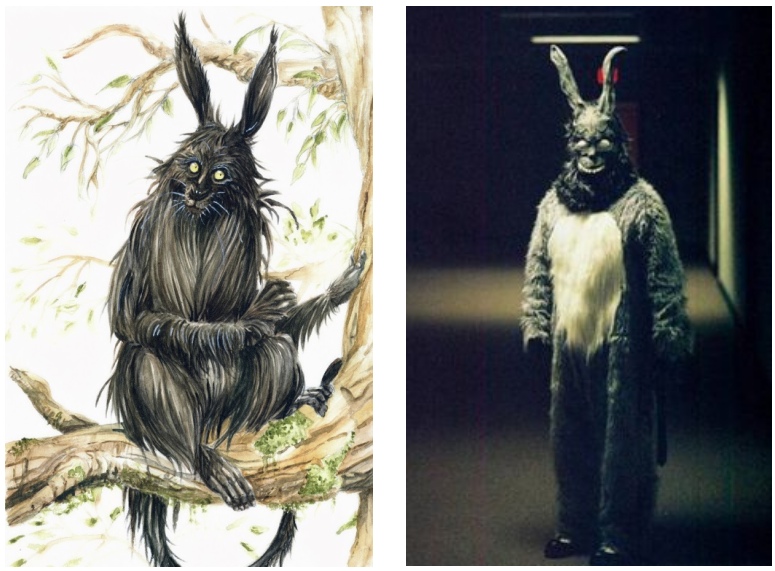
Another creature called a Koschei, similar to the púca, was said to be able to use magic and could not be killed by conventional means. In various folklore the Koschei’s soul was hidden separate from its body, through ‘talisman’ and other ‘animate objects’. The soul could be inside a needle, which is inside an egg, which is in a duck, which is in a hare, which is in an iron chest, buried under a green oak tree, which is on the island in the ocean. The soul of the Koschei is not dissimilar to the concept of Sauron in Tolkien’s Lord of the Rings, whose essence of being was ‘contained’ within a ring that was ‘connected to’ other rings, etc. Legends say that anyone ‘possessing the egg’, for example, has the Koschei in their power. If the ‘egg’ is tossed about, the Koschei likewise is flung around against his will. If the needle is broken, Koschei will die. When the ring is destroyed so is Sauron’s power, etc, etc. The Magic associated with the Koschei is that of an ‘invisible form’ that could ‘move through different realities’. The hare (and white rabbit) symbollically speaking were said to be able to move through different worlds and become ‘timeless’.
The Primordial ‘Easter Egg’ of fire
Another symbol of Easter is the egg of course, which is a universal symbol for birth and ‘new life’. The ‘primordial egg’ holds the seed from which the whole of manifestation was said to ‘spring’ from. The idea that the universe was ‘born from an egg’ is shared by nearly all ancient civilizations and cultures. The ‘primordial man’ was also said to originate from an egg, see William Blake’s image of the Four Zoas (below). The egg is symbolically the ‘boundary of the restriction’ of ‘matter’ for the human being, and here is shown surrounded by the four bodies of the mind, emotions, senses and imagination.
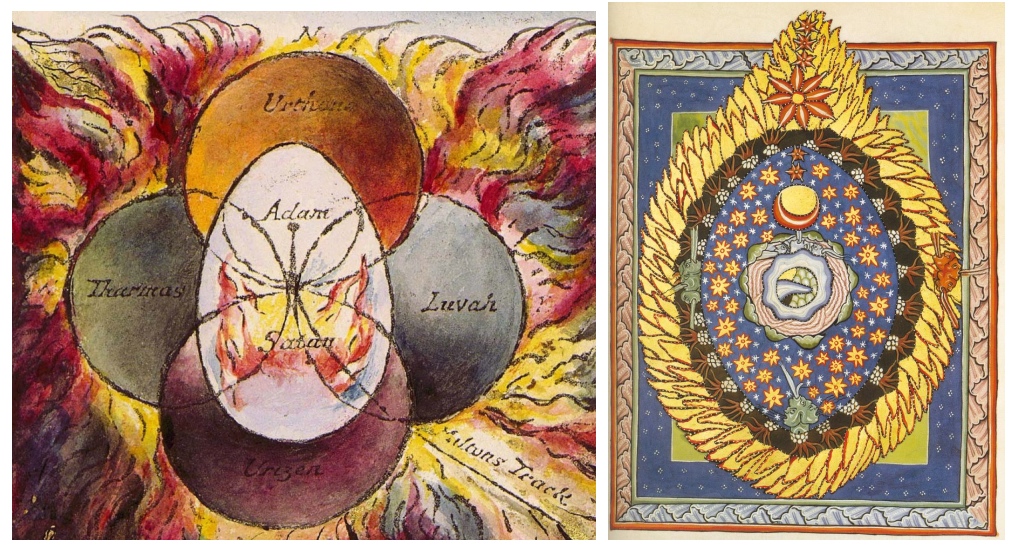
The cosmic egg, born from primordial Waters, in some myths, splits into two halves to give birth to Heaven and Earth (Symbolised as Adam and Satan in Blake’s image), or as the Hindu Brahmânda and the ‘two Dioscuri’ in Greco-Indian myths. In Hindu mythology, Brahma – the omniscient, the source of all that exists, forms out of the golden embryo and egg. According to Hindu belief, he was the self-born ‘uncreated creator’, the first manifestation of the one’s existence. As the embryo from which the universe originates, he is also called Hiranya Garbha (golden embryo), the ball of fire. The egg also signifies the polarization of the Hermaphrodite in some instances and was a symbol for the beginning of life. For the ancient Egyptians, ‘life emerged’, by the action of a ‘Demiurge’, through the ‘Nun’, (the personification of the primordial Ocean) that ‘gave birth’ to the egg. Chinese legend tells of how an enormous ‘black egg’ was formed in the darkness at the beginning of time. Inside this egg, the sleeping giant Pan Gu was formed (below left). Likewise, Hanuman the monkey king was said to be born of primal chaos, hatching from a ‘stone egg’ impregnated by the sky and the Gnostics also talk of Heaven and Earth, symbolised by the ‘world egg’ in the womb of the universe. Not a crucifixion in sight here folks? Just a human (light being) born of the cosmos.
The Egg as the Soul
Barbara Marciniak’s book Earth uses the symbolic depiction of the primordial egg and of course for anyone who has read the ‘channeled books by this author will find ‘reptilian themes’, who also ‘lay eggs’.

In terms of symmetry, astronomy and sacred geometry the egg has been used by alchemists to depict the ‘cycles within cycles’ and the ‘relationship’ between the Earth the Moon and the Solar System. The elite Elizabethan occult magician Dr John Dee, likened the origin of the planets to the metamorphosis of an egg made up of the four elements (the Zoas), which a scarab beetle brings along a spiral path. Dee referred to the ‘egg white’ as the work of the Moon (Saturn) and the ‘yoke’ the Sun (Jupiter).
Barbara Marciniak’s book Earth uses the symbolic depiction of the primordial egg and of course for anyone who has read the ‘channeled books by this author will find ‘reptilian themes’, who also ‘lay eggs’. The Druids saw the egg as the ‘sacred emblem’ of their initiation rites, hence the importance of the egg in spring (at Easter). The procession of the Goddess of agriculture, Ceres, in Rome, was preceded by an egg and it was often depicted entwined by a serpent or crowned by a crescent moon. The illustration below shows two ways the druids (Priests) represented their sacred eggs.

In the mysteries of Bacchus in ancient Greece the egg was a consecrated emblem that symbolised the ‘soul’ and this symbolism was portrayed in the move Angel Heart, when Louis Cyphre (Lucifer), played by de Niro peels an egg and eats it as a symbol of the ‘consumption of the soul’. The eye and egg are another symbol for the ‘theft of the soul’, or the visionary limits of ‘perception’ placed on humanity by the Demiurge. All over the ancient world, from China to Babylon, the egg was also painted, and venerated as symbol of ‘re-birth’ and the ‘soul’. The ‘soul of humanity’ ‘captured’, ‘bound’ or ‘eaten’ is a common theme through the use of the ‘symbol of the egg’, see my Illustration below (middle).
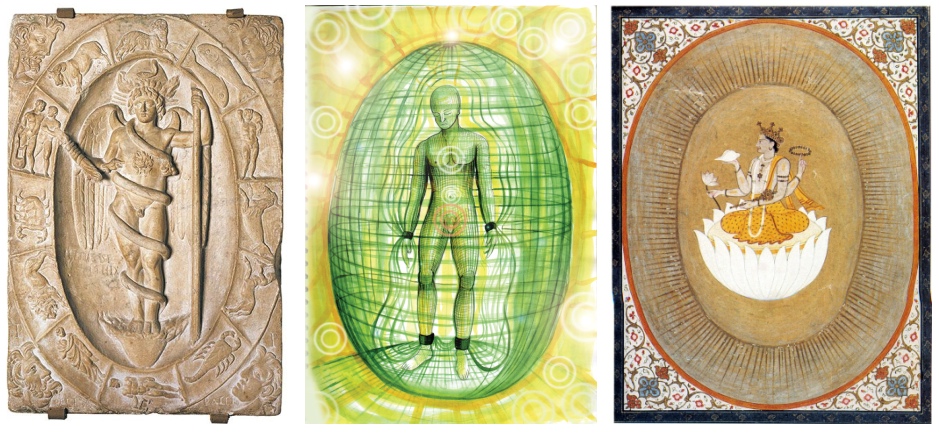
The ‘alchemical Modena’ relief (above left) also symbolises both the ‘world’ and the ‘egg’. Inside the egg (Modena), Mithras or Phanes (the light of the world) emerges with his lighted torch surrounded by a mandorla of the zodiac (corresponding to the twelve ‘altar fires’ in the Pythagorean cult). The mandorla can also represent the vulva, and thus the arrival of a ‘new being into the world’ through the goddess. The mandorla is also a sign of union, climax, opening and departure into a new life. Not a Roman Catholic or Orthodox Christian theme insight here!
‘Born’ of the Easter Egg
The reptilian symbolism associated with the egg is obvious and it could be that the ‘Babylonian religion’ that originally gave us Easter, relates to the reptilian deities that were ‘openly worshiped’ by the Akkadian and Sumerian mystery schools. The connections between reptilian gods and a new human made in the ‘likeness of the gods’, can be visually understood through the symbolism of the egg. Renaissance artists that were in the know, often used the egg as a symbol for the ‘new human’ born of a goddess.

Hieronymus Bosch’s painting ‘Concert inside an Egg’ depicts his knowledge of alchemy, the philosophical Egg and the ‘light that can be seen with the ears’ (below left). The ‘light’ is the electromagnetic forms that the brain translates into pictures and sounds, hence the light that can be seen with the ears. Bosch also includes humans that are ‘entering into’ an egg in his masterpiece ‘Garden of Earthly delights’ painted in the 15th Century. The strange creatures and imagery contained within the scene are reminiscent of reptilians/greys and naked humans (Adam and Eve prototype) of course are ‘being born’ in reverse, or being ‘encased’ in the egg – through the limitation of their DNA. The egg is also a symbol for the Moon and its control over our biological bodies’.
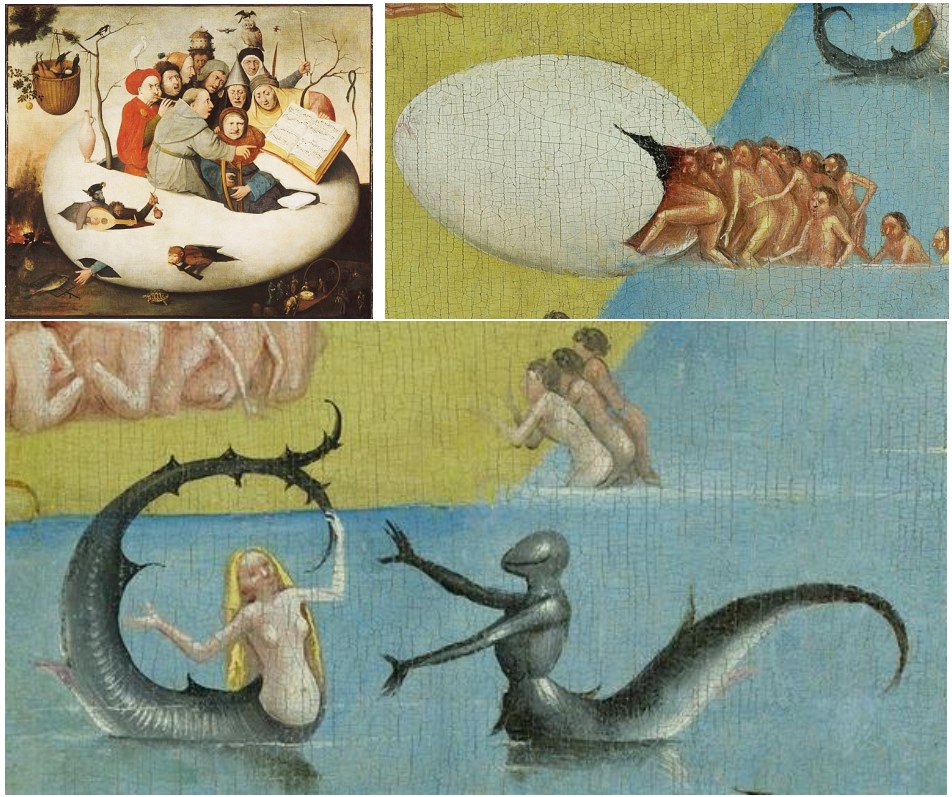
In paintings by lenaordo Da vinci and Bachiacca (below) the Greek myth of Leda and the Swan (a bird that symbolised Venus) uses the symbolisim of the children ‘born of an egg’ (just as reptiles are). The egg and its nest are also symbolic of the goddess and the word for nest, ‘shechinot’, in Hebrew is virtually the same as shekinah which means the ‘feminine glory of God’ come to ‘dwell on earth’. It literally means ‘dwelling’ or ‘presence’. Interestingly the hare also builds a ‘form’ which looks like a ‘birds nest’, another ‘visual idea’ that could have given life to the ‘Easter egg’?
In the Leda and the Swan myth, Zeus takes the form of a swan and seduces the goddess Leda, whose offspring, Castor and Pollox, are born as ‘hybrid humans’, part-god, part-human. The myths and paintings showing these narratives are hinting at the ‘copulation’ of ‘non-human’ with ‘humans’ in the ancient world. The egg symbolism, at Easter is in many ways, is a symbol for this knowledge, which was understood by the mystery schools of antiquity.
A New World Egg (Order)
On another level the egg is a symbol for a ‘new world’. Salvador Dali painted Geopoliticus Child Watching the Birth of the New Man (above right) during the Second World War. A painting that clearly symbolizes ‘change’ and a ‘new world’ being born. Dali’s initial notes for the work read: “parachute, paranaissance, protection, cupola, placenta, Catholicism, egg, earthly distortion, biological ellipse. Geography changes its skin in historic germination.”
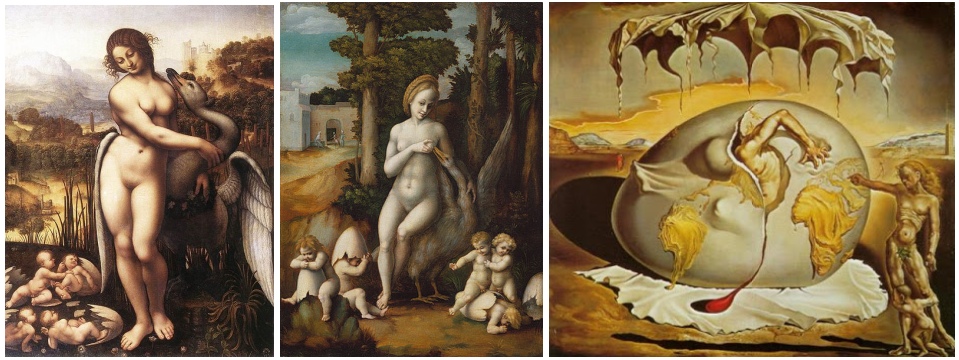
Dali’s words offer some hint of the work’s meaning. At the bottom right of the painting, the gaunt body of a classical figure, symbolises the ‘old world’ and its emaciated civilization, revealing a central scene to a child, who peeks at the male figure struggling out of a terrestrial globe, distorted into the shape of an egg. This surreal scene is emblematic of the emergence of a ‘new political order’ after the war. The central scene of global rebirth is protected by a parachute-like floating cupola that, when seen in conjunction with the cloth at the bottom, forms an ‘oyster-like shape’, another symbol for the Moon and the Christian Kingdom of Heaven. The emerging figure bursts out from the North American continent, which Dali saw as a centre of ‘historic germination’ (the growth of the new world order). The alchemical ‘great work of the ages’ is also connected to the philosophers egg and much more besides.
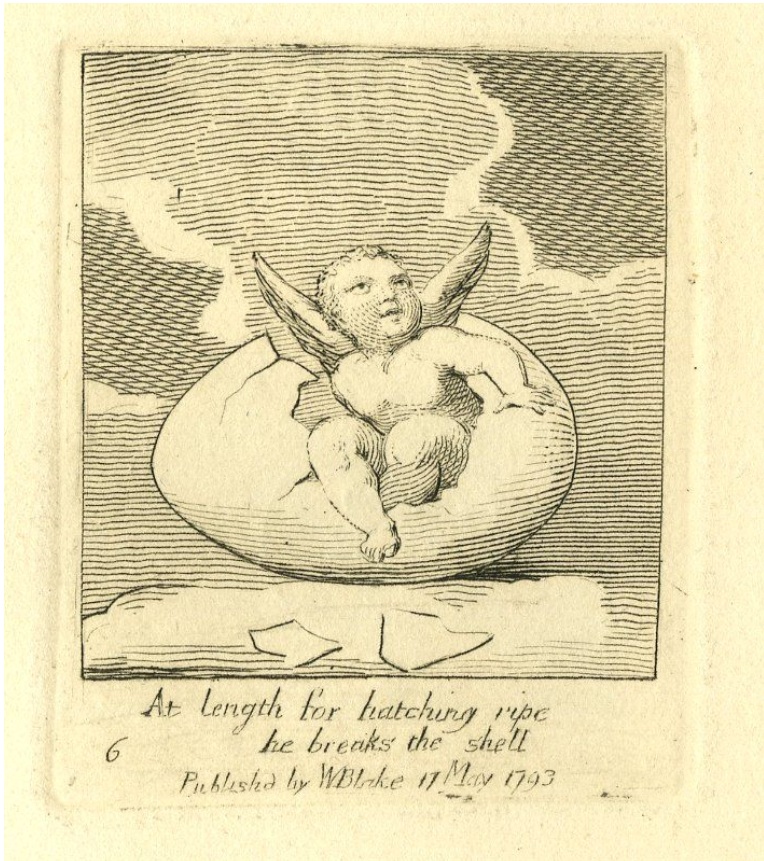
Personally, I always see Easter time as a period of ‘transition and renewal’, a time for ‘new ideas’ and ‘new beginnings’. William Blake’s image of a winged infant emerging from a cracked egg also hints at the awakening themes mentioned above. Blake had no time for orthodox religion and was aware of the Pagan roots of Christianity. The image is one of many from his collection of writings and drawings called The Gates of Paradise and this one in particular shows a ‘hatching’ of a winged infant (or cherub with Blake’s face) breaking free of the confinement imposed by the egg. According to Blake ‘the child becomes acquainted with the functioning of his mind through four spheres (the Zoas mentioned earlier) of the body, mind, imagination and emotions’. These bodies ‘give form’ to the ‘egg shape’ and signifies mankind’s ‘limited field of vision’. Writing in 1793, He said:
“An immense/Hardened shadow of all things upon our vegetated Earth, /enlarged into dimension and deformed into indefinite space”. After his death, man tears this “veil of nature” which freezes all life”
If anything, Easter is the festival of visible ‘new light and life’ and the symbolism behind the ‘Moon Egg’, the ‘Hare’ and the ‘Goddess’ are the core symbols for this time of year.
Until next time
Neil



